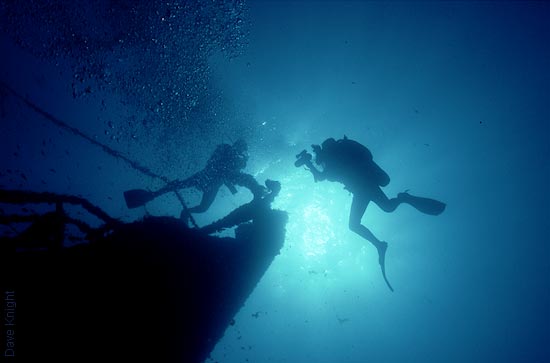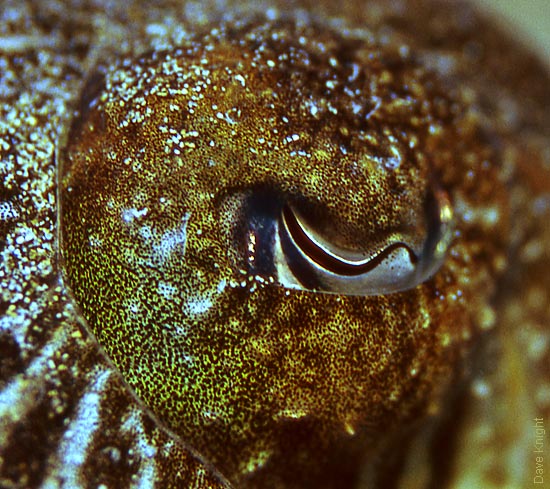Natural vs.
artificial light in underwater photography
By David Knight
There are many situations in which the use of natural light underwater
can provide good, or at least interesting, results; especially if the
camera has the facility to output 48 bits/pixel data (i.e., RAW) or
allows manual white-balance adjustment. This however, should not be
taken to mean that, just because some photographs can be taken using
available light, then all photographs should be taken using available
light. In general, natural light photography only gives good
results when conditions above water are bright and sunny, when the
depth is reasonably shallow, and when the objects to be photographed
are not in shade. Thus, if you have artificial lighting equipment
(flash or video light), you should take it with you unless absolutely
sure that it won't be needed.
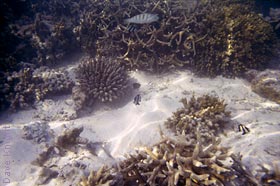 |
At very shallow depths (0 - 4 m), with bright sunlight
above, there is usually plenty of light, but the ripple pattern of the
surface is projected on to the bottom and often has greater contrast
than any potential subject (see left). The way to overcome this effect
and obtain even illumination is to stop-down the lens, increase the
shutter speed, or reduce the ISO sensitivity (or all three) until
natural light is insufficient for an exposure, and then use flash. |
At greater depths, all is gloomy; with impenetrable shadows, and
filtration of the light by the water gives rise to a strong blue-green
colour cast. The loss of red light, relative to blue, amounts to
approximately 1 f-stop (i.e., the light is halved), for every 2.5 m of
light path. It is possible to compensate for the colour shift
by applying white-balance adjustment, and the adjustment range can be
increased by using an underwater colour correction (UWCC) filter; but
filters absorb light, necessitating large apertures (reduced depth of
field) or long exposure times (risk of motion blur) or high ISO
sensitivity (increased electronic noise); and large colour shifts
necessitate very high gain in the red imaging channel (which can give
rise to red-coloured noise in the picture). At great depth also, or for
very long light paths, red light all but disappears, and you might as
well revert to black and white. Hence, if the situation allows
artificial lighting to be used, then it should be used. Also,
it should be noted that flash is to be preferred for fast-moving
objects (such as fish) because it eliminates motion blur.
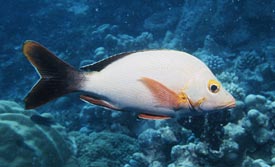 |
In the image on the left, flash has been fired from a
range of just over 1 m, i.e., the total light path is about 2.5 m, and
red is attenuated relative to blue by about 1 f-stop. Colour is well
recorded, but the pink body of the fish is beginning to turn blueish. A
small white balance adjustment performed on the 48 bpp data in
Photoshop
produces the image shown below. |
| The picture on the right was taken without flash about
1s after the one shown above. The depth underwater is about 15 m, so
red
is about 6 f-stops weaker than blue. The same picture is shown below
after WB adjustment. There simply isn't enough red light for
a full colour picture, and so the bright pink fish is recorded as being
grey. |
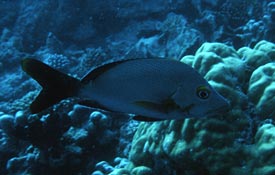 |
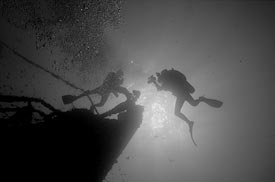 |
The sunburst is one type of picture that cannot usually
be improved by using artificial light. This one was taken in the Canary
Is. from a depth of about 20 m. Red is therefore about 8
f-stops weaker than blue, and the picture is effectively monochrome.
On the left is shown what happens if the colour saturation is
turned to zero. The black-and-white version is technically better than
the blue one, but the colour serves to tell the viewer immediately that
it was taken underwater. |
For macro photography, artificial lighting is generally considered to
be essential; the issue being that a small lens aperture is required if
acceptable depth of field is to be obtained. Since cameras are usually
hand held, the required small aperture has to be achieved in
conjunction with a reasonably short exposure time, and the lighting
must be correspondingly bright. If the camera can be placed on the
ground or used with an underwater tripod however, exposure times can be
increased and natural light macro photography becomes feasible. Use of
natural light is not the technique of first choice for close-up work,
but it does permit photography of animals that become skittish (or
delicate animals, such as seahorses, which die) when flash is fired at
them.

(above) Cuttlefish hiding in sand, Lanzarote. Natural
light at about 4 m depth, bright sunshine overhead. 48 bpp data
colour-corrected using Photoshop.
(right) Original image with colour cast is shown on the right. Note
that poor results are to be expected if large corrections are applied
to 24 bpp image data. |
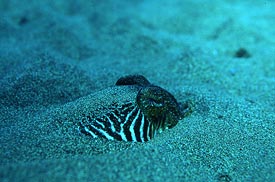 |
Cuttlefish eye, same animal as in the previous photograph. Natural
light macro photograph (hence the restricted depth of field) at 4 m
below surface. 48 bpp data colour-corrected using Photoshop. The camera
was placed on the sand next to the animal, allowing a fairly long
exposure time (about 0.1 s). Natural light was used because the flash
battery had gone flat, but it is doubtful that the animal would have
permitted such proximity had flash been fired at it during the
approach.
© D.
W. Knight. 2001, 2006, 2012, 2018
David Knight asserts the right to be recognised as the author of this
work.







